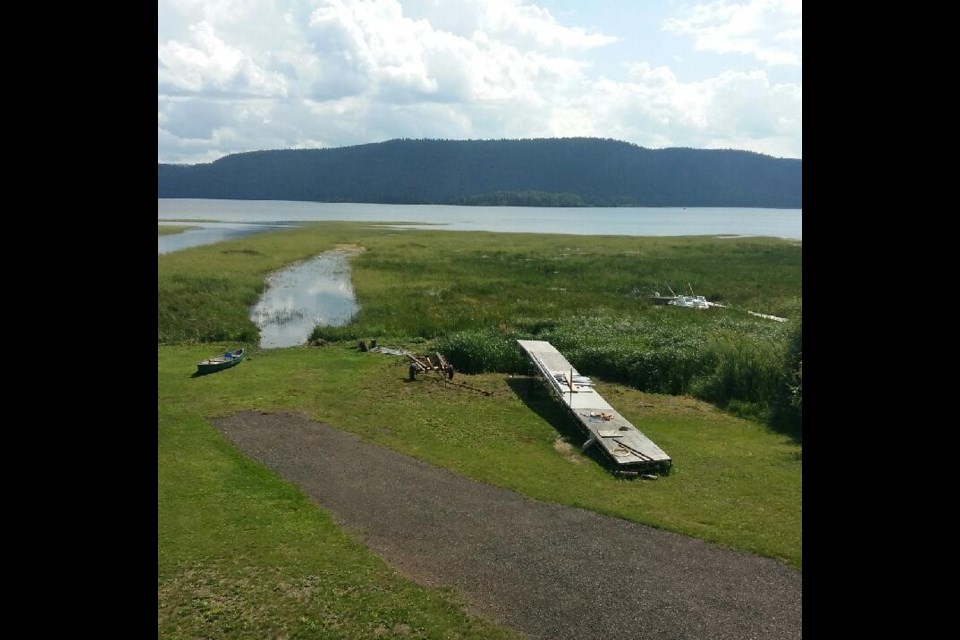THUNDER BAY — "I'm trying to clean it out, but I can't keep up with it. It's just incredible stuff," said Whitefish Lake homeowner Scott Karl.
He was speaking Tuesday about the presence of an invasive plant, the Flowering Rush, on a portion of the lake located southwest of Thunder Bay.
It's been there for years, but Karl said it's spreading to the point where "this lake is going to close down on this side pretty soon. I'm just trying to get somebody to look at this."
According to the Invasive Species Centre in Sault Ste. Marie, the Flowering Rush was confirmed to be established at Whitefish Lake at least as early as 2000.
It's a perennial aquatic plant native to Eurasia and Africa, and was introduced to North America in the 19th century as an ornamental plant for ponds and water gardens.
It''s typically found as an emergent plant in shallow water, from the shoreline to a depth of about three metres.
When it flowers, it's pretty, but once it's established, it can out-compete native vegetation and create dense stands that impede swimming, boating or fishing.
Flowering Rush, now found in all provinces and most of the northern U.S., can also alter water quality, leading to reduced biodiversity and changes to fish and wildlife habitat.
Ontario has attempted to restrict its spread under the Invasive Species Act, which makes it illegal to import, deposit, release, grow, buy, or sell it.
A typical plant produces 20 – 50 flowers which emerge from early summer to mid-fall and grow in a cluster that resembles an umbrella.
Here's how Flowering Rush can be identified:
- Numerous flowers on an erect, leafless flowering stalk over 1.5 m (4.9 ft) tall.
- Flowers are stalked, emergent, and pink in colour with 3 sepals and 3 petals. 2 – 2.5 cm (0.8 – 1 in) wide.
- Leaves are erect, floating, or submersed. 5 – 10 mm (0.2 – 0.4 in) wide, up to 2.7 m (8.9 ft) long.
At Whitefish Lake, lodge-owner Tina Reed echoed her neighbour Scott Karl's worries about the plant's presence on the northwest side of the lake.
"It's predominantly gathered within this end, and all the private property-owners as well as the resorts here. About three of us that are resort operators are severely impacted, because it's sort of taken over in this whole end of the lake, and it's become like the Great Wall of China."
She said "it's a ton of work" to try to remove it from the water.
"Within the limitations that the Ontario government allows, which is right in front of our resort, we're allowed to so that we're able to get our docks out and we have a channel for the boats to get in and out of. But it's such a manual effort. We feel like we're fighting a losing battle."
Reed said she and her husband do their best by going out in a boat with a "beaver fork or a rake of some sort to get in underneath it, and pull the bulbs and the roots right out of the water, let it dry out, and remove it completely from the water . . . I would say it's about a mile-long area that is just full of this stuff. It's just incredible to make a little bit of headway" against it.
She's also concerned that some other property-owners may unwittingly be helping to spread the Flowering Rush by running their motorboats through the plants.
According to the Invasive Species Centre, boats can easily break off fragments of the plant and establish new populations. Fragments of Flowering Rush are very hardy and can survive out of water for several weeks, increasing the likelihood of human-mediated transport between water bodies by boats or equipment.
Reed said some individuals on the lake run their boats through in an effort to make a channel, "so it's just cutting it, and then it continues to spread."
She said she'd like to get the word out in the area about how the plant is affecting Whitefish, and how to properly remove it.
"It strangles out all the other water life in the shoreline area, and it's starting to impact the fish, too - the amount of fish that are in the lake. Some birds like the pelicans are starting to herd them into these areas that are impacted with the Flowering Rush. It's just a matter of time before it devastates the fish life in the lake. It's starting to crowd out the wild rice, even water lilies and things like that."
Karl said he, too, is concerned about the fish population.
"The pelicans come in here and feed on the fish. They do like a half-circle and herd them towards the plants, and their heads just go up and down, up and down. They're cleaning the lake, as the fish can't escape."
The Flowering Rush has also reportedly been found in at least one other area, just west of Thunder Bay.
